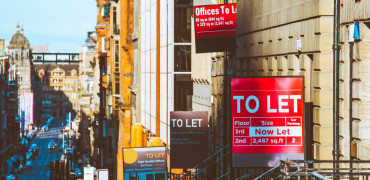As we start a New Year that will see elections in at least 64 countries around the world, one thing that we can be certain of, is that 2024 will be a year full of uncertainty.
In addition to the UK’s election of a new government, which some are predicting for either May or November, the other two that could have the most direct impact on the UK are the election for the European parliament in June and the US Presidential election in November.
Whilst I’m not here to go into the politics of these events, this will mean a period of uncertainty that will impact on our economy and will in turn, affect construction, investment and the built environment.
Which is why I think it’s worth looking at the latest Sustainability Index, published by CBRE (Coldwell Banker Richard Ellis) who are the global leader in commercial real estate services and investments.
Their annual report compares the investment performance of efficient and inefficient buildings (or assets) and covers another period of uncertainty – from the first quarter of 2021 to the beginning of the second quarter of 2023.
Green building practices are not just an option but a strategic imperative
How the report is prepared
The research analyses the investment performance of these assets based on energy efficiency in four categories: At an ‘all property’ level; for the Office sector; the Retail sector; and the Industrial sector.
Across these categories, it compares performance for efficient verses inefficient buildings and concludes that a focus on efficiency leads to a better return for investors.
It is worth downloading The Sustainability Index 2023 report for yourself to explore how the research shows that more energy efficient assets had better investment performance over the period.
CBRE analyses over 1,000 properties across England and Wales (that are regularly valued) and then creates an index of investment performance based on their energy efficiency ratings.
The research uses the Energy Performance Certificates (EPCs) for each building as the basis for the energy efficiency ratings.
The sample is from properties with a combined capital value of £17.7 billion, and rental value of £1.2 billion (as at Q2 2023).
Although CBRE adds a caveat that the report is not seeking to prove a causal relationship between energy efficiency and investment performance, for me, it is pretty clear that when it comes to global investment, efficiency is once again a major factor.
Emissions – a global imperative
The CBRE Sustainability Index 2023 not only highlights the financial advantages of energy efficiency in commercial real estate but also aligns with the pressing global imperative to reduce carbon emissions.
As the United Kingdom intensifies its drive toward net zero emissions and with the built environment accounting for a significant 40% of the country's carbon footprint, the findings of this report bear profound implications for the future of sustainable real estate investment.
In this brief exploration, I’ll delve deeper into the interplay between the CBRE Sustainability Index, Energy Performance Certificates (EPCs), the Minimum Energy Efficiency Standard (MEES), and the UK's ambitious net-zero targets.
Energy Efficiency as a Strategic Advantage
The Sustainability Index draws its foundation from EPCs, providing a tangible and standardized metric for energy efficiency in commercial properties.
As the UK government reinforces its commitment to a sustainable future, properties with higher EPC ratings are emerging as strategic assets, positioned to deliver better financial returns while contributing to the broader national goal of reducing carbon emissions.
Meeting the Minimum Energy Efficiency Standard
The Minimum Energy Efficiency Standard (MEES) serves as a regulatory framework mandating that commercial properties meet a minimum EPC rating of 'E.'
The CBRE Sustainability Index echoes the significance of adhering to these standards, as properties falling below this threshold face potential financial repercussions.
Investors and property owners are compelled to reassess and upgrade inefficient assets, not only to comply with regulations but also to enhance their overall financial performance.
It aligns the advantages of efficiency with the imperative to reduce carbon emissions
Office Sector Dynamics
Efficient offices have not only weathered the storm more effectively but have also delivered superior total returns since the inception of the index.
With an annualized total return of -1.4%, efficient offices outperformed inefficient offices, which posted a return of -4.6%.
The trend is attributed to the two-tier state of the UK office market, with high demand for energy-efficient spaces driven by corporate net-zero targets.
Retail Sector Insights
In the Retail sector, efficient assets recorded stronger total returns than inefficient ones.
Despite both efficient and inefficient assets experiencing a decline in capital values over the last 12 months, efficient retail assets exhibited positive capital growth since the index's beginning, in contrast to the decline observed in inefficient buildings.
Industrial Sector Dynamics
Interestingly, energy-efficient industrial assets delivered slightly weaker investment returns than their inefficient counterparts.
However, this is attributed to strong market forces driving performance in the sector, with high demand for industrial spaces and limited pressure to upgrade existing assets for energy efficiency.
Sector-Specific Dynamics
The Index reveals nuances in different sectors, reflecting the varying degrees of emphasis on energy efficiency.
While energy-efficient offices demonstrate superior resilience and returns, the Retail sector illustrates the impact of property mix on overall performance, emphasizing the importance of tailoring sustainability strategies to the specific characteristics of each asset.
Challenges and Opportunities in the Industrial Sector
The Industrial sector, despite presenting slightly weaker returns for energy-efficient assets in the Index, underscores the need for a nuanced approach.
As the demand for industrial spaces remains high, there is an opportunity to leverage sustainability initiatives that align with broader net-zero objectives while meeting the unique demands of the sector.
Conclusion
The CBRE Sustainability Index not only provides a snapshot of the current state of sustainable real estate investment but also acts as a compass for navigating the future.
In the context of the UK's ambitious net-zero targets, the commercial real estate sector is poised for a transformative journey.
Investors, stakeholders, and policymakers can draw valuable insights from this index to align their strategies with the evolving landscape, contribute to national sustainability goals, and thrive in a market where green building practices are not just an option but a strategic imperative for a resilient and sustainable future.
Dan Smith is Sustainability and Construction Manager




